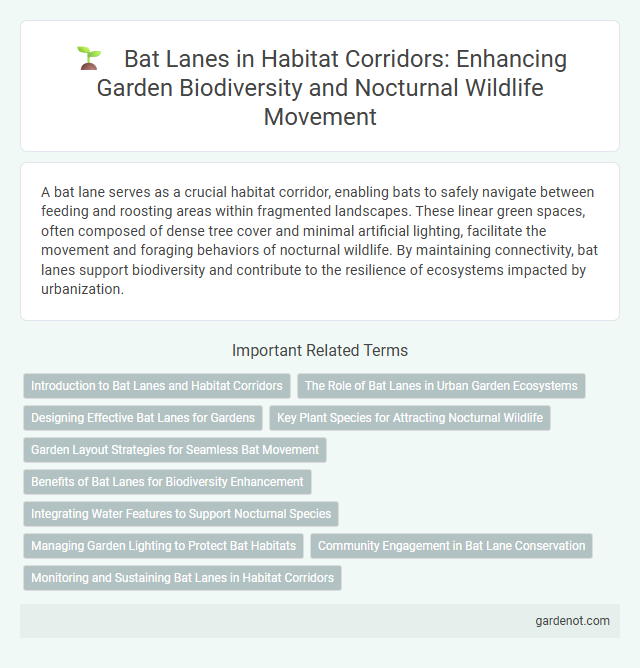A bat lane serves as a crucial habitat corridor, enabling bats to safely navigate between feeding and roosting areas within fragmented landscapes. These linear green spaces, often composed of dense tree cover and minimal artificial lighting, facilitate the movement and foraging behaviors of nocturnal wildlife. By maintaining connectivity, bat lanes support biodiversity and contribute to the resilience of ecosystems impacted by urbanization.
Introduction to Bat Lanes and Habitat Corridors
Bat lanes serve as crucial habitat corridors that connect isolated roosting sites, facilitating safe navigation and foraging for bats across fragmented landscapes. These corridors enhance biodiversity by maintaining genetic flow and reducing mortality risks caused by urban development and road traffic. Integrating bat lanes into urban planning supports ecosystem health and promotes sustainable wildlife conservation efforts.
The Role of Bat Lanes in Urban Garden Ecosystems
Bat lanes in urban garden ecosystems serve as critical habitat corridors that connect fragmented green spaces, enabling bats to forage and navigate safely through cities. These linear green pathways enhance biodiversity by supporting nocturnal insect control, contributing to pest management in urban gardens. Integrating bat lanes into urban planning fosters ecological connectivity, promoting healthier, more resilient urban biodiversity networks.
Designing Effective Bat Lanes for Gardens
Designing effective bat lanes for gardens involves creating continuous, dark, and sheltered pathways that mimic natural habitats, facilitating safe bat navigation and foraging. Incorporating native trees and shrubs with dense foliage enhances roosting options and insect abundance, supporting bat populations. Maintaining minimal artificial lighting along these corridors prevents disturbance, ensuring bats can traverse gardens securely and contribute to local biodiversity.
Key Plant Species for Attracting Nocturnal Wildlife
Bat lanes, designed as habitat corridors, rely heavily on key plant species such as night-blooming jasmine, moonflower, and evening primrose to attract nocturnal wildlife. These plants provide essential nectar sources and insect habitats, supporting bats' foraging activities. Incorporating native species like white oak and hackberry further enhances insect diversity, which is crucial for sustaining healthy bat populations along the corridor.
Garden Layout Strategies for Seamless Bat Movement
Designing garden layouts with native plants, dense shrubbery, and strategically placed water sources creates effective bat lanes that support continuous winged mammal movement. Incorporating vertical elements such as tall grasses and trees enhances navigation and provides shelter, ensuring functional connectivity within habitat corridors. Optimizing spatial arrangement reduces light pollution and human disturbance, fostering seamless bat transit through urban and suburban green spaces.
Benefits of Bat Lanes for Biodiversity Enhancement
Bat lanes serve as essential habitat corridors that facilitate the safe movement and foraging of various bat species, promoting genetic diversity and population stability. These corridors enhance biodiversity by connecting fragmented habitats, allowing bats to access diverse food sources such as insects and nectar while supporting pollination and pest control services. Implementing bat lanes also helps mitigate the impacts of urbanization, reducing mortality risks from vehicles and artificial lighting, thereby sustaining local ecosystem health.
Integrating Water Features to Support Nocturnal Species
Integrating water features within bat lanes enhances habitat corridors by providing essential hydration and insect-rich foraging grounds for nocturnal species. These aquatic elements create microhabitats that support diverse bat populations, promoting biodiversity and ecosystem health. Strategic placement of ponds, streams, or wetlands along corridors facilitates safe navigation and resource access during nighttime activity.
Managing Garden Lighting to Protect Bat Habitats
Managing garden lighting within bat corridors is essential to preserve natural foraging and commuting behaviors of bat species such as the common pipistrelle (Pipistrellus pipistrellus). Using low-intensity, warm-colored LED lights and shielding fixtures minimizes light pollution, reducing disruption to nocturnal insect activity that forms bats' primary food source. Strategic placement of lighting away from key roosts and flight paths enhances habitat connectivity, supporting biodiversity conservation in urban and suburban garden landscapes.
Community Engagement in Bat Lane Conservation
Community engagement plays a crucial role in Bat Lane conservation by fostering local stewardship and raising awareness about the ecological importance of these habitat corridors. Involving residents through citizen science projects and educational workshops enhances monitoring efforts and encourages the adoption of bat-friendly practices. Strong community participation supports the maintenance and restoration of Bat Lane habitats, ensuring long-term connectivity and biodiversity preservation.
Monitoring and Sustaining Bat Lanes in Habitat Corridors
Monitoring bat lanes within habitat corridors involves using acoustic detectors and thermal imaging to track bat activity and species diversity, ensuring accurate data collection. Sustaining these corridors requires maintaining vegetation structure and minimizing artificial light pollution to preserve foraging and commuting pathways for bats. Regular ecological assessments and adaptive management strategies are critical to support bat population health and habitat connectivity.
Bat lane Infographic

 gardenot.com
gardenot.com